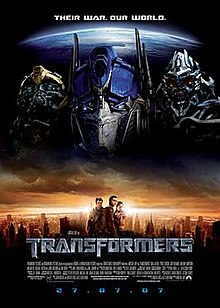- :
- Unknown
- :
- Original screenplay
- needed to precede following dl
- :



- :
- 131 minutes (Uncut)
- Review Format:
- DVD
- :
- 2013
- :

- Predominant Genre:
- Action
- Directors:
Director Guillermo del Toro 
- :
Outstanding Performances Mana ASHIDA - Premiss:
- Aliens threaten Earth with dinosaurs that humans decide can only be beaten by giant robots.
- Themes:
- Advertising | Alienation | Capitalism | Corporate Power | Emotional repression | Globalisation | Grieving | Love | Loyalty | Materialism | Narcissism | Nostalgia | Parasitism | Passivity | Personal | Personal change | Political | Political Correctness | Propaganda | Redemption | Republicanism | Role modeling | Sadomasochism | Schizophrenia | Solipsism | The State | Stereotyping | Terrorism | Totalitarianism | The West | Western culture | White culture | White people
- :



- Spin-offs:
- Unknown
The usual Caucasian War on Terror metaphor; suggesting the enemy (the Kaiju here) are simply monsters – without any motive that would make them at least seem rational.
Pretending the enemy’s behavior makes little sense is an evasion of the fact that to understand them would automatically offer painful insight into:
- Oneself;
- one’s weaknesses; &,
- one’s unethical desires.
Indeed, despite attempts at human/Kaiju mind-melding, no attempt is ever seriously made to understand the Kaiju; making them harder to defeat.
The Green Berets-style attempt to justify unwinnable wars by claiming the young are the most threatened by malevolent forces bent on wanton demolition makes no survival sense. For any creature to completely destroy what they feed-off would be suicide (like leaving a job before having another to go to), yet this logical absurdity is completely side-stepped by the screenwriters who, themselves, feed‑off irrational notions to spend and make large sums of money.
Instead, the audience’s attention is focused on the unsubstantiated White belief that humanity would come together to fight a common, external enemy. Something humanity has never done, historically – and are not doing in the current War on Terror. (If Whites win, they will return to fighting the very people who helped them, since the White ego leads White people to believe they are either a conquering army or a resistance force – never able to share anything with anyone else.)
In this movie, we only see the dependency of mutual need exemplified by a technology which appears to make two weak people into one person, rather than two strong individuals working synergistically together. Thus, no gestalt or symbiosis is ever truly established regarding the blind White faith-in-technology which they believe will somehow save them, when the real source of many White problems is the very White ideology that worships such technology, in the first place.
Yet, this movie’s love of industrial production (analogous to the mass-production involved in the film’s making) ultimately leads to the masochistic worship of destruction that is on show here, since what is produced is not spiritually-satisfying and, thus, not felt to be worth preserving. As money-without-wealth (credit) produces boom-and-bust economic cycles; construction-without-meaning helps produce recurring wars (within & without) Western cultures against that very meaninglessness. White people clearly sense their culture is inherently-fragile since it is based on a de facto need for conflict which, inevitably, dooms it from within.
These battling robots and roaring dinosaurs are little more than movie-merchandising opportunities, since this movie’s overly-complex, Heath Robinsonesque way of waging war makes no operational, tactical nor strategic sense. However, they are a good means of dramatizing the combat into individualized fisticuffs – rather than the emotionally-uninvolving spectacle of well-trained warriors clashing en masse.
Yet, despite these attempts at humanizing the drama, humans here are still shown as desperately wanting to survive without a fulfilling reason to do so (apart from rather bland sexual & paternal love stories). A motivating purpose to being alive is evaded in favor of implying that all that people want is simply not to die; inevitably leading to the solacing schadenfreude of hoping others (the Kaiju) are suffering greater existential angst than oneself, to make one’s own existence appear more satisfying – in comparison – than it actually is.
The humor – and the many references to the erstwhile glories of the best Japanese monster movies – serve only to distract attention from the essential emptiness of this exercise in blockbuster Hollywood movie-making (while inadvertently pointing-it-up), in which CGI monumentalism, computer-generated dialog & willful over-acting substitute for a convincing plot, worthwhile characters & an engrossing story.




No comments:
Post a Comment